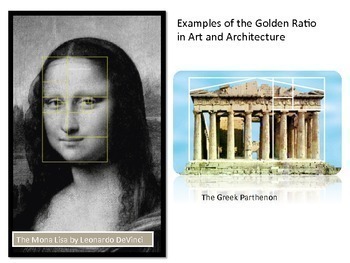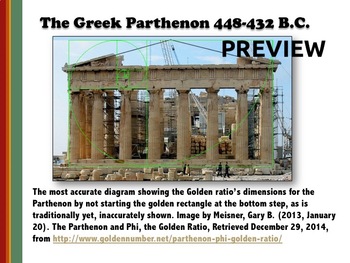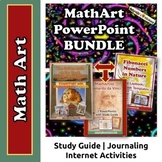Golden Ratio Fibonacci Numbers PowerPoint Thematic Unit | Distance Learning
- Zip
- Internet Activities
Also included in
- Math With Art is NatureGlo's MathArt Animated PowerPoint BUNDLE with student study guides and Internet Activities! This product is a remarkable growing culmination of 17 years of private school and online homeschool teaching. My homeschool parents tell me that MathArt is the missing link in modern dPrice $155.50Original Price $189.00Save $33.50
Description
This study is great for doing STEM/STEAM projects AND summer learning! This popular bundle introduces the golden ratio or golden number and the Fibonacci number series in three in-depth thematic unit studies.
The golden ratio and Fibonacci number series can be found in nature, art, and architecture and has been studied by famous artists and scientists such as Leonardo da Vinci and Rembrandt. The Fibonacci number series (0, 1, 1, 2, 3, 5, 8, 13...etc.) and the Hindu-Arabic numerals we use today (1 - 9 and 0), were introduced to the west by Leonardo Pisano Bigollo, also named Leonardo of Pisa, to Europe in about 1202 A.D. in his book, Liber Abaci or the Book of Calculations.
What's included:
- 3 PowerPoints (in .pptx and pdf formats)
- 2 study guides
- Fibonacci numbers foldable or lapbook
- NatureGlo's Virtual Library Internet Activities links including projects, activities, and videos
- Answer keys
- Rubric for student projects
PowerPoint Topics:
- Intro to the Golden Ratio & Fibonacci Numbers
- The Golden Ratio & Fibonacci Numbers in Art, Architecture, and Nature
- Fibonacci Numbers in Nature
Study Guides include:
- PowerPoint questions
- Journal templates
- Quizzes
- Student project rubrics
- Answer keys
Subjects Covered:
- Mathematics of the golden ratio and Fibonacci numbers
- History of the discovery and use of the numbers
- Art connections
- Nature science connections
- Engineering - architecture where these numbers are used
- Writing - journal templates about student's favorite "MathArtists" and math concepts using the Golden ratio and Fibonacci numbers
Also Check out:
********************
Math Art Science Thematic Distance Learning Coronavirus Full year Courses
PowerPoint & Activity Guide: The Golden Number and Fibonacci PowerPoint
The Golden Ratio & the Great Pyramid Unit Study
LOOKING FOR A FULL YEAR OF MathArt and SCIENCE PLUS SUMMER eLEARNING?
Also Check out:
********************
MathArt Full Year Curriculum (great for grades 3 - 8)
I'd love to stay connected with you! Connect with me now on:
*******************************************************************************
NatureGlo's eScience YouTube Channel
NatureGlo's eScience Pinterest
Got questions? Email me at natureglosescience@gmail.com
Happy learning adventures!
Gloria aka NatureGlo






